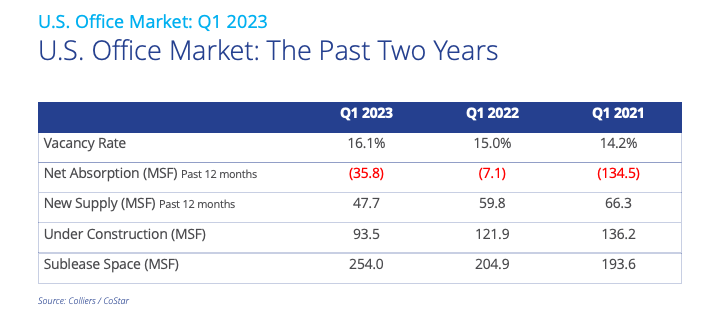The softening in U.S. office market fundamentals, seen in Q4 2022, accelerated in the first quarter of 2023. As a result, net absorption remained negative and occupancy losses increased, while vacancy rose at a faster pace, and sublease space hit a record high.

Here’s a summary of the key trends:
- The U.S. office vacancy rate stands at 16.1%, up 40 basis points from the fourth quarter. Vacancy in this cycle looks set to exceed the record peak of 16.3%, seen at the height of the Global Financial Crisis.
- The gap between asking and effective rents remains significant. Tenant improvement allowances of $100 per square foot or more, accompanied by up to 10 to 18 months of rent abatement, are available for Class A space in several leading metros.
- U.S. office absorption totaled negative 25.4 million square feet in Q1 2023, compared with negative 14.1 million square feet in Q4 2022. Less than a quarter (24%) of markets tracked in our survey saw positive absorption in the first quarter, down from 43% in Q4 2022.
- The amount of office space under construction in the U.S. stands at 94.5 million square feet, down 43% from this cycle’s peak of 162.6 million square feet in Q3 2020.
- Total sublease space available at a national level increased by 11.2 million square feet in the first quarter to 254 million square feet. In an analysis of rental discounts for Class A sublease space over Class A direct space across the leading office markets, the average discount is 29%.

Is a market correction ahead? Firms continue to recast their property strategies. Tenant downsizing has become the norm, with space reductions of at least 20% to 30% being implemented by large occupiers. While existing lease obligations will temper the pace of such changes, the net result will be sustained upward pressure on vacancy.
Pending a resurgence in demand, vacancy rates and sublease availability are set to continue to rise over the rest of 2023, and into 2024, placing increased pressure on rents. Retrenchment in the finance, government and tech sectors, which were key drivers of leasing volume pre-Covid, could compound this trend.
With repricing already occurring on the sales side, it seems only a matter of time before it takes place in the rental market driven by the triple-hit of downsizing, sublease space and rising vacancy rates, as landlords become increasingly aggressive to secure tenants.
Where’s the upside? Performance and demand differentials are expected to widen. Bifurcation should be most evident between space class and age. Opportunities should become more selective, but quality will win out as firms seek the optimal work experience to retain and attract the best talent and bring employees back to the office.

 U.S. National Research
U.S. National Research

 Sheena Gohil
Sheena Gohil Bob Shanahan
Bob Shanahan Dougal Jeppe
Dougal Jeppe Kai Shane
Kai Shane
 Bret Swango, CFA
Bret Swango, CFA Michelle Cleverdon
Michelle Cleverdon
 Aaron Jodka
Aaron Jodka